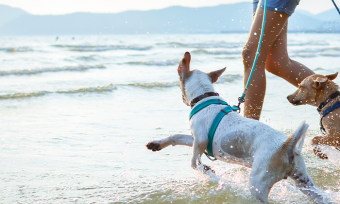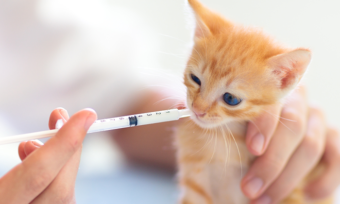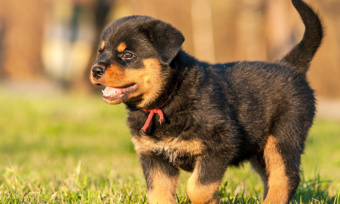KEY POINTS:
- Dogs can pee inside for a few reasons, including being shut inside too long, illness, anxiety, marking territory and lack of training.
- Don’t punish your dog for peeing inside, as this could make the problem worse.
- Ways to stop your dog from peeing include: establishing a set route for them to pee outside, removing any causes of stress in your dog’s life, positive reinforcement.
- If you can’t solve the problem yourself, you may need to consult a dog behavioural therapist.
Are you struggling to stop your dog from peeing inside? Don’t worry, you’re not alone. This is a common problem that many pup parents face. And, thankfully, according to the pet experts at pd.co.nz, there are a few things you can do to help your dog break the habit of urinating inside.

Why is my dog peeing inside?
Dogs urinating inside when they shouldn’t can be a bit of a puzzle sometimes – especially when they’re no longer puppies. There are several common reasons why they might do it:
Lack of training
If your dog has been peeing indoors since they were a puppy then, perhaps, they lack training. This is a really good area to work on before worrying about other causes.
It takes time and patience to house train a dog, but it’s definitely possible. Be consistent with your training, and be sure to reward your dog for going outside to pee.
Illness
If your dog has only recently started peeing inside, their behaviour could be caused by disease or illness, such as a bladder infection. And if your pet is unwell, you might have noticed other symptoms, such as increased thirst.
If this is the case, it’s advisable to schedule a consultation with your veterinarian.
Anxiety
Anxiety can also be a cause of dogs urinating, and it can manifest in various ways.
When a dog is feeling anxious or stressed, they can urinate indoors as a coping mechanism. This can be triggered by factors such as changes in your household, thunderstorms or loud noises. If you suspect that your dog is anxious or stressed, try to identify the source of their anxiety and, if possible, address it.
You can also focus on behavioral training to calm your dog. Additionally, creating a safe space where they can retreat to if they’re feeling insecure can prove helpful.
Boredom
Boredom can cause some dogs to pee inside a home. Dogs require mental stimulation as much as they need physical exercise. If your dog is bored, they may start exhibiting undesirable behaviors, such as urinating indoors. Ensure that your dog has plenty of activities to engage in, such as toys to play with, regular walks and training sessions.
Territorial dominance
This behaviour is more common in unneutered male dogs, but it can also occur in females. Marking territory is a way for dogs to communicate with each other, and it can be triggered by factors such as the introduction of new pets or people into the household, or changes in the environment.
If peeing is a new behavior that has developed with the arrival of a new family member, whether it’s another pet or a human, your dog may be perceiving the new arrival as a threat within the household.
Lacking outside time
Dogs need to urinate regularly, so if they’re not getting enough chances to go outside, they might start going inside. Ensure that you take your dog out to pee at least every three to four hours, and more frequently if they are young, old, or have a medical condition.
How can I stop my dog peeing inside?
Once you’ve established that your dog isn’t urinating inside the house for medical reasons, you can focus on positive reinforcement training and other measures. Here are some steps that you can take:
1. Establish a routine
Dogs thrive on routine. Take your pup out at the same time every day: after meals, when they wake up and before bedtime. This helps them understand when it’s time to go outside.
Consistency is key in dog training. Stick to your routine and reinforce positive behaviour. It might take some time, but your dog will learn!
2. Use positive reinforcement
When your dog pees outside, praise and reward them with treats and affection. Positive reinforcement reinforces the idea that peeing outside is a good thing. Don’t scold or punish your dog for urinating inside, as this can make your dog fearful and anxious. They may associate urination with your anger, which can lead to stress and anxiety, making the problem worse.
On top of that, dogs live in the present moment, so if you scold them for something they did earlier, they might not connect the punishment to the action. This can lead to confusion and won’t help them understand the correct behaviour.
3. Watch for signs
Pay attention to your dog’s cues. Sniffing, circling, or whining can be signs they need to go out. Quickly take them outside when you notice these behaviours.
4. Create pee-free zones
If your dog is having accidents, don’t give them free rein of the house. Use baby gates or a crate when you can’t supervise them closely. This prevents accidents and gives them fewer opportunities to pee inside.
5. Clean well
When accidents happen it’s a good idea to clean any indoor messes with an enzymatic cleaner. This helps eliminate the smell that can attract your dog to pee in the same spot again.
6. Be patient
Understand that accidents are part of the learning process. As mentioned, don’t scold or punish your dog for accidents inside the house.
7. Neuter or spay your dog
Desexing a dog is not just about birth control, it can help prevent indoor peeing, too. Here’s how it helps:
- Less territory marking: it can calm down the dog’s urge to mark their territory with pee. That’s a big win for preventing indoor accidents.
- Better behaviour: you’ll often notice an improvement in your dog’s behaviour after the procedure. They might become more focused and easier to train.
8. Consider professional help
If you think you need help then seek it from your vet or consider contacting an accredited behaviourist. A pet behaviourist can be a real lifesaver when you’re dealing with tricky pet problems. Here’s how they can lend a helping hand:
- Understanding your pet’s mind: these experts are like pet psychologists. They get inside your pet’s head to understand why they’re acting the way they are, whether it’s chewing furniture, being aggressive, or peeing indoors
- Custom solutions: once they figure out the root cause, they’ll create a tailored plan to fix the issue. No one-size-fits-all here; it’s all about what works best for your dog
- Training tips: animal behaviourists are like personal trainers for your pets. They’ll teach you effective training techniques to reinforce good behaviour and eliminate your dog urinating inside
- Communication: sometimes, our pets have trouble communicating their needs or emotions. Behaviourists can help you understand what your pet is trying to tell you, so you can respond appropriately
- Peace in the home: by working with an animal behaviourist, you can bring peace and harmony back to your home. No more torn-up couches, constant barking or pee where it shouldn’t be
Compare pet insurance providers here!
About the reviewer of this page
In his role at Canstar, he has been a regular commentator in the NZ media, including on the Driven, Stuff and One Roof websites, the NZ Herald, Radio NZ, and Newstalk ZB.
Away from Canstar, Bruce creates puzzles for magazines and newspapers, including Woman’s Day and New Idea. He is also the co-author of the murder-mystery book 5 Minute Murder.







Share this article